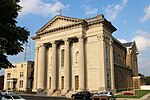The Seville
Apartment buildings in IndianaIndianapolis stubsMarion County, Indiana Registered Historic Place stubsNational Register of Historic Places in IndianapolisResidential buildings completed in 1921 ... and 2 more
Residential buildings in IndianapolisResidential buildings on the National Register of Historic Places in Indiana

The Seville was a historic apartment building located at Indianapolis, Indiana. It was built in 1921, and was a three-story, C-shaped, building on a raised basement. It featured elaborate Spanish-influenced terra cotta ornamentation and a wide overhanging stamped tin boxed cornice.: 3 It has been demolished. It was listed on the National Register of Historic Places in 1987.
Excerpt from the Wikipedia article The Seville (License: CC BY-SA 3.0, Authors, Images).The Seville
Pierson Street, Indianapolis
Geographical coordinates (GPS) Address Nearby Places Show on map
Geographical coordinates (GPS)
| Latitude | Longitude |
|---|---|
| N 39.789722222222 ° | E -86.158611111111 ° |
Address
Pierson Street
46202 Indianapolis
Indiana, United States
Open on Google Maps







